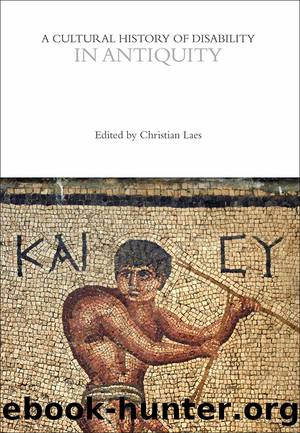A Cultural History of Disability in Antiquity by Christian Laes;

Author:Christian Laes;
Language: eng
Format: epub
Publisher: Bloomsbury UK
FIGURE 5.1 Ear votive, Roman (© Wellcome Images L0035833).
FIGURE 5.2 Mouth and teeth votive, Roman (© Wellcome Images L0058490).
In biblical studies, âmetaphors of physical and cognitive impairment sometimes serve as figures of moral deficiencyâ (Melcher 2007: 123). The Christian priest and theologian Jerome commented on the passage âfaith comes by hearingâ (Rom: 10.17), with the potential implication that the deaf could not follow God (but see King 1996: 4). Jerome was broadly a contemporary of St. Augustine, who is often stated as being responsible for this negative view. King (1996: 112) has made a convincing case that St. Augustine has been systematically misinterpreted by those citing the relevant reference from Contra Iulianum, including, after a series of Chinese whispers, the mainstream Encyclopedia Britannica. St. Augustine seems to have been receptive to the idea that sign and gesture could stand in for speech (McBurney 2012: 912). These comments parallel the confusion about Aristotleâs supposed pronouncement regarding the cognitive abilities of deaf people; what is important to highlight is how Antiquity has accidentally and unintentionally influenced modern thinking to reinforce a negative view of the disabled condition. Here, the influence of Antiquity stems more from a mishearing of these sources, rather than their direct voice.
The Midrash on Psalm 34 embraces all bodily states, including disability, as part of the divine master planâapart from madness, which David finds unaccountable (Avalos et al. 2007: 1). This runs counter to the approach of modern Western medicine, with its focus on fixing the body (playing God? See also miracle cures, for example, as recounted by Gregory of Tours: Laes 2011b: 457). This clash of ethical stances comes to the fore in debates over abortion and euthanasia, but it may also be seen between medics and disability groups, including the Deaf community. In Britain, the former are served by charities such as Action on Hearing Loss (AoHL; formally the Royal National Institute for Deaf People [RNID]), a large charity with close links to the medical community (much of this chapter was written in The Ear Institute and Action on Hearing Loss Library, based in the Royal National Throat, Nose and Ear Hospital in London). The latter are served by the Royal Association for Deaf People (RAD) or the much smallerâand poorerâmember-run British Deaf Association (BDA), which focuses on the Deaf community and promotes the use of sign language: this is much more a celebration of Deaf culture rather than the pursuit of âfixesâ for the broken ear. While this approach does not evoke divine forces, they are similar in the acknowledgment and acceptance that things are as they are meant to be. The occasionally hostile friction between the advocates of the AoHL and the supporters of the BDA rise from very different responses to deafness (Adams 2018). The extraordinary advances in modern medicine, which increase the ability and value of human intervention, is the single main difference between Antiquity and modernity, and inevitably has had a marked effect on the role, status, and authority of religions.
5.8. GESTURE
Download
This site does not store any files on its server. We only index and link to content provided by other sites. Please contact the content providers to delete copyright contents if any and email us, we'll remove relevant links or contents immediately.
4 3 2 1: A Novel by Paul Auster(11780)
The handmaid's tale by Margaret Atwood(7445)
Giovanni's Room by James Baldwin(6801)
Asking the Right Questions: A Guide to Critical Thinking by M. Neil Browne & Stuart M. Keeley(5353)
Big Magic: Creative Living Beyond Fear by Elizabeth Gilbert(5347)
Ego Is the Enemy by Ryan Holiday(4948)
On Writing A Memoir of the Craft by Stephen King(4658)
The Body: A Guide for Occupants by Bill Bryson(4577)
Ken Follett - World without end by Ken Follett(4441)
Bluets by Maggie Nelson(4258)
Adulting by Kelly Williams Brown(4230)
Eat That Frog! by Brian Tracy(4147)
Guilty Pleasures by Laurell K Hamilton(4112)
White Noise - A Novel by Don DeLillo(3825)
The Poetry of Pablo Neruda by Pablo Neruda(3812)
Fingerprints of the Gods by Graham Hancock(3731)
Alive: The Story of the Andes Survivors by Piers Paul Read(3724)
The Book of Joy by Dalai Lama(3690)
The Bookshop by Penelope Fitzgerald(3615)
